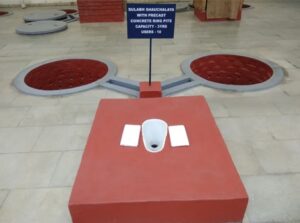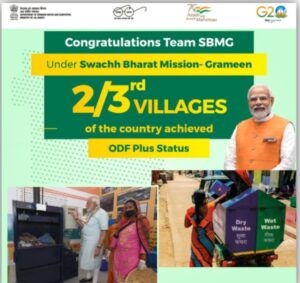Thank You Mr Pathak.
Relevance
- GS Paper 2 Development Processes and the Development Industry — the Role of NGOs, SHGs, various groups and associations, donors, charities, institutional and other stakeholders.
- Tags: #SulabhSanitationRevolution #EndingManualScavenging #SwachhBharatInspiration #InnovationForSocialChange.
Why in the news?
Bindeshwar Pathak famously called as “Toilet Man of India”, was a visionary social reformer, Pathak, born into the Brahmin caste, immersed himself in the Dalit community in Bettiah to study socio-economic conditions, developed the groundbreaking Sulabh toilet, a cost-effective and environment-friendly solution that aimed to eliminate the practice of manual scavenging.
Early Challenges and Inspirations
• Open defecation was a Common Practice throughout much of the country, and not even the privileged were exempted
• Septic tanks were expensive, and only a relatively small number of communities had reliable sewer systems.
• There were hardly any Public Toilets.
• The Dalit community was given the responsibility of cleaning up the night soil (human excreta).
• Joined the Gandhi Centenary Committee, Moved by message of Mahatma Gandhi’s message of restoring the dignity of the scavenging community, made replacing the bucket latrines a priority.
Innovation of Sulabh Toilet
• Sulabh toilet is a low-cost, waterless toilet that uses a biogas digester to treat human waste.
• The digester converts the waste into methane gas, which can be used for cooking or lighting.
Features of the Sulabh toilet include
1. Non-Sewer System: Unlike conventional toilets that require connection to a sewer system, the Sulabh toilet does not rely on sewers. This is particularly useful in areas where sewer infrastructure is lacking or too expensive to implement.
2. Two-Pit Design: The Sulabh toilet features a two-pit design, allowing for easy switching between pits. This enables the waste to decompose naturally, reducing the need for constant cleaning and maintenance.
3. Composting:The waste collected in the pits can be used for composting, turning it into a valuable resource for agriculture.
4. Water Efficiency: uses significantly less water compared to conventional flush toilets, conserving water resources.
5. Customizable: The design of the Sulabh toilet can be adapted to local conditions, making it suitable for various geographic and cultural contexts.
6. Hygiene and Dignity: The Sulabh toilet provides a clean and odorless sanitation solution, improving hygiene standards and restoring dignity to users.
Revolution Sulabh Toilets Brought
Early success and Struggle
• The Arrah municipality gave Pathak Rs 500 in 1973 to build two toilets in the office complex. Through mouth publicity.
• The Bihar government issued a directive to all local authorities in 1974 encouraging them to enlist Sulabh’s assistance in converting bucket toilets into two-pit pour-flush toilets.
• Municipal Corporations provided the land and money for the building of the restrooms but declined to cover maintenance cost.
• Pathak was forced to charge users for using public facilities.
• In Patna alone, 25,000 people were utilizing Sulabh public facilities by 1980.
• Sulabh contributed significantly to building and maintaining toilet blocks in educational institutions.
Impact Sulabh Toilets Made On Life of People.
Elimination of Manual Scavenging
• Reduction of manual scavenging, a dehumanizing practice where individuals, often from marginalized communities, were forced to manually clean human waste.
• By providing an alternative sanitation solution, Sulabh toilets have contributed to ending this inhumane practice and restoring dignity to affected individuals.
Improved Public Health
• The availability of clean and hygienic sanitation facilities through Sulabh toilets has led to improved public health outcomes.
• Open defecation and inadequate sanitation were major contributors to the spread of diseases like cholera, diarrhea, and other waterborne illnesses.
• Sulabh toilets have helped decrease the prevalence of these diseases by providing a safer and more sanitary option.
Enhanced Hygiene
• The design of Sulabh toilets focuses on maintaining cleanliness and reducing odors.
• This has not only improved overall sanitation practices but has also led to a positive change in hygiene habits within communities.
Behavioral Change
• The availability of Sulabh toilets has encouraged a shift in behavior away from open defecation.
• Embraced the concept of using toilets, leading to a cleaner environment and reduced contamination of water sources.
Social Upliftment
• breaking down caste-based barriers associated with sanitation work, enabled individuals from marginalized communities to access improved sanitation facilities without being subjected to discriminatory practices.
Economic Benefits
• Resulted in economic savings for households and communities.
• Reduced incidence of waterborne diseases leads to fewer healthcare expenses, and the compost produced from the toilets can be used as a valuable resource in agriculture.
Educational Impact
• The availability of proper sanitation facilities, including in schools, has encouraged higher attendance rates among students, particularly girls.
• This has contributed to better education outcomes and empowerment, as lack of proper sanitation facilities was a major reason for girls dropping out of schools.
Environmental Sustainability
• The composting feature of Sulabh toilets promotes environmental sustainability by turning waste into a valuable resource.
• This reduces the need for chemical fertilizers and waste disposal, benefiting both the environment and agriculture.
Community Development
• The construction and maintenance of Sulabh toilets have often involved local communities, contributing to community engagement, empowerment, and development.
Government Initiatives
• The Success of Sulabh toilets has influenced and supported government initiatives like the Swachh Bharat Abhiyan (Clean India Campaign),
• Aims to achieve open defecation-free India.
• Sulabh toilets have been a practical solution in achieving the campaign’s objectives.
Swachh Bharat Abhiyan
Swachh Bharat Abhiyan, also known as the Clean India Campaign, was launched by the Indian government on October 2, 2014, with the aim of achieving a cleaner and healthier India.
Primary objectives of the campaign include
• Elimination of Open Defecation: One of the main goals is to ensure that every household in the country has access to proper sanitation facilities, thus eliminating the practice of open defecation.
• Safe and Scientific Waste Management: The campaign aims to promote responsible waste management practices, including proper disposal and recycling of waste to maintain a cleaner environment.
• Behavioral Change: seeks to bring about a change in people’s attitudes and behaviors towards cleanliness and hygiene.
• Clean Public Spaces: The campaign aims to clean up public areas, streets, and roads, making them more aesthetically pleasing and promoting a sense of civic responsibility.
• Awareness and Education: Swachh Bharat Abhiyan aims to create awareness about the importance of cleanliness and hygiene through education and communication.
Successes of Swachh Bharat Abhiyan
• Significant Reduction in Open Defecation: The campaign has led to a substantial decrease in open defecation across the country. Millions of toilets have been constructed, providing millions of people with access to proper sanitation facilities.
• Increased Awareness: Swachh Bharat Abhiyan has created a national conversation about cleanliness and hygiene. People are more aware of the impact of their actions on the environment and public health.
• Behavioral Change: The campaign has contributed to changing behaviors, with many communities embracing the use of toilets and proper waste disposal practices.
• Recognition and Awards: Swachh Bharat Abhiyan received international recognition and awards for its efforts to improve sanitation and cleanliness, Like Champions of the Earth Award by the United Nations Environment Programme (UNEP) in 2019, Goalkeeper Award by the Bill and Melinda Gates Foundation in 2019, Public Private Partnership Award by the World Bank in 2018, Water for Life Award by the World Economic Forum in 2017.
Areas Where We Are Lacking
Despite the successes, there are still areas where the Swachh Bharat Abhiyan faces challenges.
Sustainability
• Ensuring the long-term sustainability of sanitation facilities and waste management practices remains a challenge.
• Regular maintenance and upkeep are crucial.
Rural-Urban Disparities
• While progress has been made in urban areas, rural areas still face challenges in terms of sanitation infrastructure and awareness.
Waste Management Infrastructure
• Adequate waste management infrastructure, including recycling facilities and proper disposal mechanisms, needs further development.
Behavioral Persistence
• Despite the awareness, some people still revert to old habits due to convenience or lack of facilities.
Funding and Implementation
• Adequate funding and effective implementation at the grassroots level remain essential for achieving the campaign’s objectives.
Monitoring and Accountability
• Ensuring that all levels of governance are actively involved and accountable in implementing the campaign’s goals can be challenging.
Source: Indian Express
Mains Question:
“Swatch Bharat Abhiyan has a potential to address the basics rural needs”. In the light of the above statement, critically analyse the success of the scheme.






